Instruction
How to hit the sweet spot more often
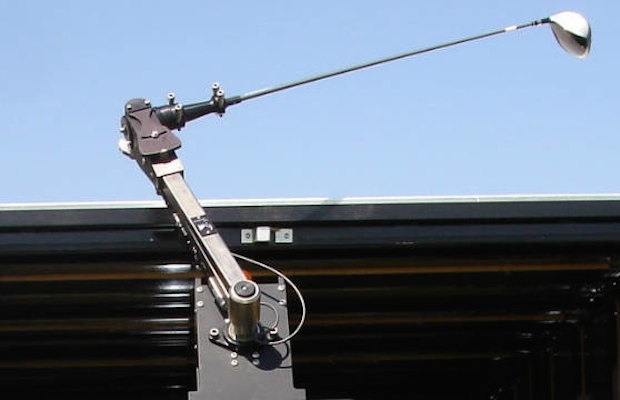
Most golfers would love to have more distance, especially if they can get it without any more effort. Good golfers don’t want to swing hard, and beginning golfers shouldn’t.
For 99 percent of all golfers, I advocate swinging rhythmically, staying within oneself and hitting the ball directly in the sweet spot, or the center of the club face. Sounds simple, right? Well, consistently hitting the sweet spot is a little bit tougher than that. And missing it usually causes a vicious cycle. You mis-hit a shot, causing the ball to come up short. In reaction, you swing harder (since that makes the ball go farther, right?), and you miss the sweet spot by a larger margin. The ball ends up equally short.
Soon enough, your swing looks like you’re playing Whack-A-Mole with a shovel. You may be one of these golfers, but if you’re not you’ve certainly have seen golfers like this hacking and toiling away, mastering powerless effort. Well, I’d like to convince you that doing only two things will guarantee that you hit the sweet spot more often.
1. Keep the 7th cervical vertebrae as centered and fixed as possible until after impact.
This bone is located at the base of the neck, and it is easy to locate because it has a bigger “bump” than the others. This point represents the center of the “swing circle.” Your head can rotate a bit during the backswing to accommodate a bigger shoulder turn as long as the base of the neck stays centered.
Many teachers over the years have advocated that the head should sway back behind the ball at the top of the swing. I also see many golfers over-turn their hips, which causes the head to sway toward the rear foot. This move will be higher maintenance, and add one more variable to an already difficult task.
Sam Snead was one of the best ever at shifting weight underneath a steady C7. He is a great model to emulate.
Sure, you can groove a swing where your head moves back and forth laterally or up and down. This is what I call “perfecting imperfection.” However, you’ll lose leverage and have a diminished chance of flushing shots.
2. Keep the radius between the 7th cervical and the butt end of the club fixed throughout the swing.
When we set up to the ball, we establish a measurement from the base of the neck to the butt of the club. I advocate having the lead arm fully extended downward without sacrificing suppleness. This makes forming a consistent measurement much easier.
Most amateur golfers will decrease this distance as they approach the top of their swings. This is sometimes known as “collapsing the arc” or “getting narrow.” Typically, you might see the lead elbow bend and the shoulders stop turning.
This would be akin to driving a train off the tracks and then hoping to steer it back on before it reaches the station. Again, why make this game harder? Instead, keep the club head on the track and on a collision course with the ball.
I advocate only swinging to the point in the backswing where you can maintain the original width you started with at address. This won’t lead to significant loss in club head speed, and it will be made up with more solid contact.
You will find that keeping the same distance you started with will require an enormous shoulder turn to reach parallel at the top. I don’t teach many people who are this flexible. Your best bet is to simply maintain the radius and live with the shorter length. You can always work on stretching it out later.
I recommend that you keep the radius fixed deep into the follow through as well. The rear arm will take control of this function about 30 inches past impact, as it fully extends. This will ensure that you don’t lose the original width going through the ball.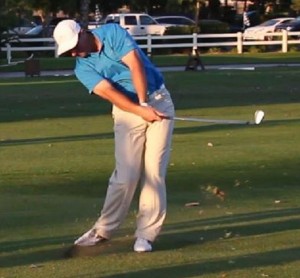
Centrifugal force will be your best friend in maintaining the constant width through the impact zone. Don’t fight it — instead allow it. Suppleness is again the key and should replace rigid arm pulling. Obviously, the turning torso helps create centrifugal force, so just don’t just use the arms alone. That will make maintaining the original arc much more difficult.
I can think of one prominent “golfer” who always adheres to these two rules: Iron Byron, the USGA’s golf ball hitting machine. It never misses the sweet spot. Not only does the robot get lots of distance, but consistent distance and accuracy.
Iron Byron has a fixed central hub, and maintains the same radius it sets up to the ball with. Of course, humans can’t be as perfect as a hitting machine, but the better we follow these rules, the more likely we will achieve repeated solid contact and achieve the effortless power that makes golf really fun.
I can’t wait to hear about your solid strikes!
- LIKE38
- LEGIT7
- WOW10
- LOL4
- IDHT1
- FLOP5
- OB4
- SHANK16
Instruction
The Wedge Guy: The easiest-to-learn golf basic

My golf learning began with this simple fact – if you don’t have a fundamentally sound hold on the golf club, it is practically impossible for your body to execute a fundamentally sound golf swing. I’m still a big believer that the golf swing is much easier to execute if you begin with the proper hold on the club.
As you might imagine, I come into contact with hundreds of golfers of all skill levels. And it is very rare to see a good player with a bad hold on the golf club. There are some exceptions, for sure, but they are very few and very far between, and they typically have beat so many balls with their poor grip that they’ve found a way to work around it.
The reality of biophysics is that the body moves only in certain ways – and the particulars of the way you hold the golf club can totally prevent a sound swing motion that allows the club to release properly through the impact zone. The wonderful thing is that anyone can learn how to put a fundamentally sound hold on the golf club, and you can practice it anywhere your hands are not otherwise engaged, like watching TV or just sitting and relaxing.
Whether you prefer an overlap, interlock or full-finger (not baseball!) grip on the club, the same fundamentals apply. Here are the major grip faults I see most often, in the order of the frequency:
Mis-aligned hands
By this I mean that the palms of the two hands are not parallel to each other. Too many golfers have a weak left hand and strong right, or vice versa. The easiest way to learn how to hold the club with your palms aligned properly is to grip a plain wooden ruler or yardstick. It forces the hands to align properly and shows you how that feels. If you grip and re-grip a yardstick several times, then grip a club, you’ll see that the learning curve is almost immediate.
The position of the grip in the upper/left hand
I also observe many golfers who have the butt of the grip too far into the heel pad of the upper hand (the left hand for right-handed players). It’s amazing how much easier it is to release the club through the ball if even 1/4-1/2″ of the butt is beyond the left heel pad. Try this yourself to see what I mean. Swing the club freely with just your left hand and notice the difference in its release from when you hold it at the end of the grip, versus gripping down even a half inch.
To help you really understand how this works, go to the range and hit shots with your five-iron gripped down a full inch to make the club the same length as your seven-iron. You will probably see an amazing shot shape difference, and likely not see as much distance loss as you would expect.
Too much lower (right) hand on the club
It seems like almost all golfers of 8-10 handicap or higher have the club too far into the palm of the lower hand, because that feels “good” if you are trying to control the path of the clubhead to the ball. But the golf swing is not an effort to hit at the ball – it is a swing of the club. The proper hold on the club has the grip underneath the pad at the base of the fingers. This will likely feel “weak” to you — like you cannot control the club like that. EXACTLY. You should not be trying to control the club with your lower/master hand.
Gripping too tightly
Nearly all golfers hold the club too tightly, which tenses up the forearms and prevents a proper release of the club through impact. In order for the club to move back and through properly, you must feel that the club is controlled by the last three fingers of the upper hand, and the middle two fingers of the lower hand. If you engage your thumbs and forefingers in “holding” the club, the result will almost always be a grip that is too tight. Try this for yourself. Hold the club in your upper hand only, and squeeze firmly with just the last three fingers, with the forefinger and thumb off the club entirely. You have good control, but your forearms are not tense. Then begin to squeeze down with your thumb and forefinger and observe the tensing of the entire forearm. This is the way we are made, so the key to preventing tenseness in the arms is to hold the club very lightly with the “pinchers” — the thumbs and forefingers.
So, those are what I believe are the four fundamentals of a good grip. Anyone can learn them in their home or office very quickly. There is no easier way to improve your ball striking consistency and add distance than giving more attention to the way you hold the golf club.
More from the Wedge Guy
- The Wedge Guy: Golf mastery begins with your wedge game
- The Wedge Guy: Why golf is 20 times harder than brain surgery
- The Wedge Guy: Musings on the golf ball rollback
- LIKE79
- LEGIT13
- WOW4
- LOL1
- IDHT0
- FLOP4
- OB1
- SHANK8
Instruction
Clement: Stop ripping off your swing with this drill!

Not the dreaded headcover under the armpit drill! As if your body is defective and can’t function by itself! Have you seen how incredible the human machine is with all the incredible feats of agility all kinds of athletes are accomplishing? You think your body is so defective (the good Lord is laughing his head off at you) that it needs a headcover tucked under the armpit so you can swing like T-Rex?
- LIKE0
- LEGIT1
- WOW2
- LOL0
- IDHT0
- FLOP0
- OB0
- SHANK2
Instruction
How a towel can fix your golf swing

This is a classic drill that has been used for decades. However, the world of marketed training aids has grown so much during that time that this simple practice has been virtually forgotten. Because why teach people how to play golf using everyday items when you can create and sell a product that reinforces the same thing? Nevertheless, I am here to give you helpful advice without running to the nearest Edwin Watts or adding something to your Amazon cart.
For the “scoring clubs,” having a solid connection between the arms and body during the swing, especially through impact, is paramount to creating long-lasting consistency. And keeping that connection throughout the swing helps rotate the shoulders more to generate more power to help you hit it farther. So, how does this drill work, and what will your game benefit from it? Well, let’s get into it.
Setup
You can use this for basic chip shots up to complete swings. I use this with every club in my bag, up to a 9 or 8-iron. It’s natural to create incrementally more separation between the arms and body as you progress up the set. So doing this with a high iron or a wood is not recommended.
While you set up to hit a ball, simply tuck the towel underneath both armpits. The length of the towel will determine how tight it will be across your chest but don’t make it so loose that it gets in the way of your vision. After both sides are tucked, make some focused swings, keeping both arms firmly connected to the body during the backswing and follow through. (Note: It’s normal to lose connection on your lead arm during your finishing pose.) When you’re ready, put a ball in the way of those swings and get to work.

Get a Better Shoulder Turn
Many of us struggle to have proper shoulder rotation in our golf swing, especially during long layoffs. Making a swing that is all arms and no shoulders is a surefire way to have less control with wedges and less distance with full swings. Notice how I can get in a similar-looking position in both 60° wedge photos. However, one is weak and uncontrollable, while the other is strong and connected. One allows me to use my larger muscles to create my swing, and one doesn’t. The follow-through is another critical point where having a good connection, as well as solid shoulder rotation, is a must. This drill is great for those who tend to have a “chicken wing” form in their lead arm, which happens when it becomes separated from the body through impact.
In full swings, getting your shoulders to rotate in your golf swing is a great way to reinforce proper weight distribution. If your swing is all arms, it’s much harder to get your weight to naturally shift to the inside part of your trail foot in the backswing. Sure, you could make the mistake of “sliding” to get weight on your back foot, but that doesn’t fix the issue. You must turn into your trial leg to generate power. Additionally, look at the difference in separation between my hands and my head in the 8-iron examples. The green picture has more separation and has my hands lower. This will help me lessen my angle of attack and make it easier to hit the inside part of the golf ball, rather than the over-the-top move that the other picture produces.


Stay Better Connected in the Backswing
When you don’t keep everything in your upper body working as one, getting to a good spot at the top of your swing is very hard to do. It would take impeccable timing along with great hand-eye coordination to hit quality shots with any sort of regularity if the arms are working separately from the body.
Notice in the red pictures of both my 60-degree wedge and 8-iron how high my hands are and the fact you can clearly see my shoulder through the gap in my arms. That has happened because the right arm, just above my elbow, has become totally disconnected from my body. That separation causes me to lift my hands as well as lose some of the extension in my left arm. This has been corrected in the green pictures by using this drill to reinforce that connection. It will also make you focus on keeping the lead arm close to your body as well. Because the moment either one loses that relationship, the towel falls.


Conclusion
I have been diligent this year in finding a few drills that target some of the issues that plague my golf game; either by simply forgetting fundamental things or by coming to terms with the faults that have bitten me my whole career. I have found that having a few drills to fall back on to reinforce certain feelings helps me find my game a little easier, and the “towel drill” is most definitely one of them.
- LIKE11
- LEGIT1
- WOW2
- LOL0
- IDHT0
- FLOP2
- OB0
- SHANK8
-

 19th Hole1 week ago
19th Hole1 week agoJohn Daly stuns fans into silence with brutal opening tee shot on PGA Tour Champions
-

 19th Hole2 weeks ago
19th Hole2 weeks ago2-time major champ announces shock retirement from the sport at age of 33
-

 19th Hole1 week ago
19th Hole1 week agoCharlie Woods finds it tough going on American Junior Golf Association debut
-

 19th Hole2 weeks ago
19th Hole2 weeks agoEdoardo Molinari reveals the latest PGA Tour golfer to turn down ‘good offer’ from LIV Golf
-

 Equipment3 weeks ago
Equipment3 weeks agoBest driver 2024: The best driver for you, as recommend by expert club fitters
-

 19th Hole2 weeks ago
19th Hole2 weeks agoScottie Scheffler had an interesting response when asked how he ‘quiets the noise’ following Players victory
-

 19th Hole2 weeks ago
19th Hole2 weeks agoJon Rahm dealt fresh blow to hopes of qualifying for 2025 Ryder Cup
-
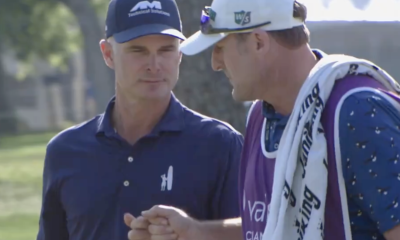
 19th Hole1 week ago
19th Hole1 week agoWhy Kevin Streelman sought USGA approval to use this equipment tool as he leads Valspar after round one

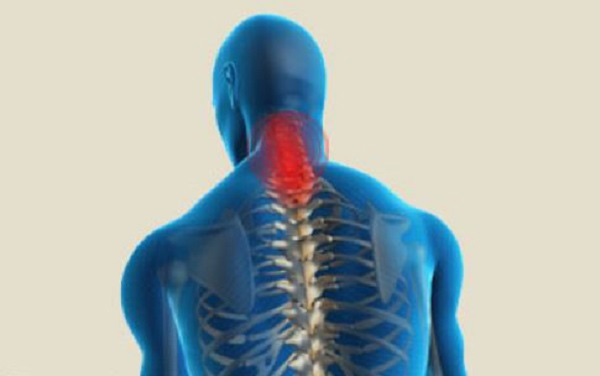
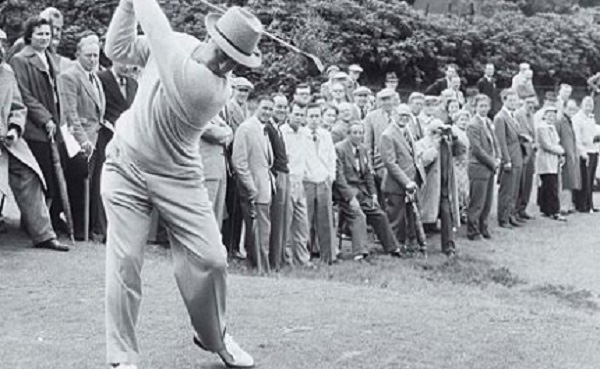












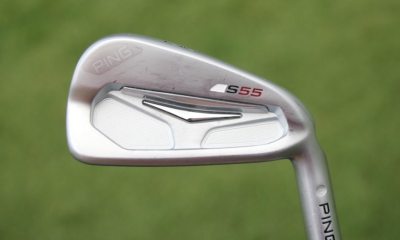

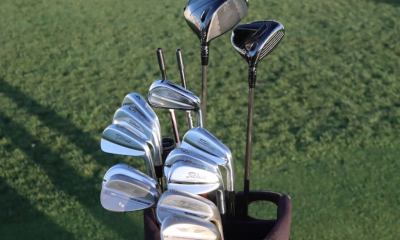

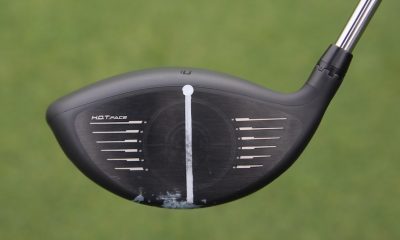

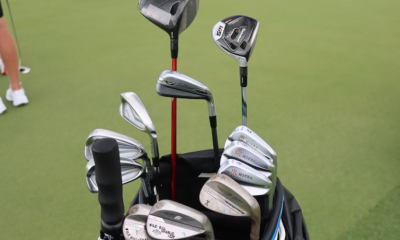

beautiful naked chicks
Apr 2, 2014 at 8:09 pm
It’s difficult to find experienced people about
this topic, however, you seem like you know what you’re talking about!
Thanks
Also visit my webpage beautiful naked chicks
Bob Jones
Mar 31, 2014 at 12:00 pm
I have noticed the first point at tournaments. If you stand behind a touring pro, so his or her back is facing you, that 7th vertebrae just does not move. Period. We always analyze a golf swing from the front or the side, so we can’t see this. But if you watch a pro from behind, the lack of motion at that spot jumps out at you.
The second pont, what I would call taking the club back to the point of control, works wonders, too. Your backswing will be shorter, but you won’t lose much, if any, distance, because you will start hitting the ball flush.
Matt
Mar 30, 2014 at 10:18 am
Nice article!
Martini122
Mar 28, 2014 at 10:32 pm
one=on
Martini122
Mar 28, 2014 at 10:30 pm
This writer needs mentoring from his local PGA professional. “I advocate only swinging to the point in the backswing where you can maintain the original width you started with at address. This won’t lead to significant loss in club head speed, and it will be made up with more solid contact”. Slammin’ Sammy “maintained his original width” . . . come one. We should all swing like geriatrics?
Jedidiah
Mar 29, 2014 at 7:40 am
You’re a geriatric